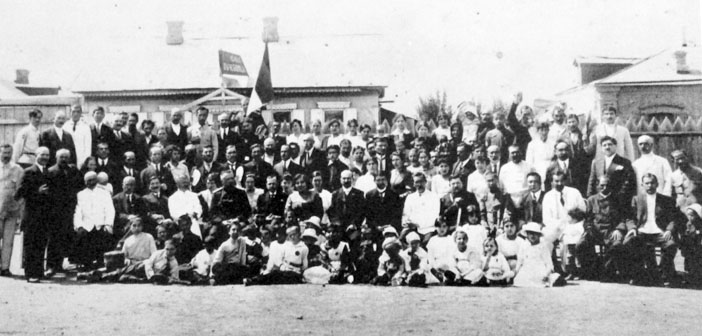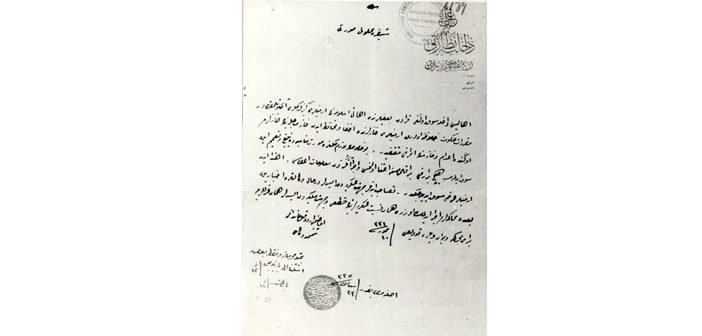Previously unreleased historical documents on the Armenian Genocide from the archives of the Vatican are being unveiled. The documents published in the periodical La Civiltà Cattolica provide significant information regarding the diplomatic attempts and aid work carried out by the Vatican during and after the Armenian Genocide.
According to the report that presents a summary of the four volumes of documents prepared by Jesuit priest Georges-Henry Ruyssen and published on March 21, the archive, which is to be published in its entirety at the end of March, includes documents on the ‘Armenian Question’ from the late 19th century until the mid-20th century. Many of the documents belong to the archive of the Congregation of Eastern Churches, and include papal correspondence with Ottoman sultans, documents belonging to the Vatican Foreign Representation and other administrative departments of the church, reports by missionaries, correspondence from Armenian patriarchs and religious clergy, and witness accounts sent to the Church.
The most important among the documents, the majority of which are being published for the first time, are the two letters sent by Pope Benedict XV to the Ottoman Sultan Mehmed Reshad V. In the first letter dated 10 September 1915, Benedict XV requests the Sultan to act against violence perpetrated against Armenians, while the second letter dated 12 March 1918 involves a request for assistance in aid work regarding Armenians. The periodical underlines that these letters show that the Vatican did not remain passive in the face of massacres and in contrast, made a genuine effort. According to the periodical’s report, Benedict XV was the only political and religious leader who raised a voice against this crime of mass proportions during that period.
According to the documents, the diplomatic attempts of the Vatican were not restricted to the abovementioned letters. The Vatican also intervened to secure the release of 60 Armenians sentenced to death in 1917 in Syria by Djemal Pasha. Furthermore, in 1921, Cardinal Pietro Gasparri, the Vatican Secretary of State, mediated with Mustafa Kemal Pasha for the protection of the lives and properties of Christians who survived the Genocide.
Pope Francis will hold mass on April 12 at the St. Peter Basilica in memory of those who lost their lives during the Armenian Genocide. There are also plans for the renowned Armenian singer Charles Aznavour to present a concert at the Vatican marking the Centennial of the Genocide.
‘Vatican documents will add a new dimension to Genocide Studies’
Yektan Türkyılmaz (Anthropologist, Zentrum Moderner Orient)
There is no doubt that the Vatican’s organization and making public for researchers of its documents on the Armenian Question and the Genocide will add a new dimension and fresh perspective to studies in this field. However, there are a few fundamental reasons that are of great significance for us. First, Catholic missions in Anatolia and Syria were founded before Protestant missions, in fact, some date back to the 17th century. Therefore, this material will provide a broader perspective about the changing conditions of Armenian groups in regions where Catholic institutions were active. On the other hand, Armenian Catholics in a number of provinces such as Ankara, Erzurum, Van, Harput, Halep and Diyarbekir, lived as rivals, and in many cases in a detached manner, to other Armenian communities. Therefore, we have much more restricted knowledge about these groups. Another issue is that many Catholic missions managed to retain their position during the Genocide. And they both sought to intervene in the situation, and were first-hand witnesses of the massacres and the destruction of communities. Access to documentation of this nature might not fundamentally change what we know about the destruction of Ottoman Armenian communities, but there is no doubt that it will add a significant layer to our knowledge. One example that immediately comes to my mind is the memoirs of the Trabzon Catholic Archbishop Nazlıyan, a very important source. Collections including the personal documents of Catholic clergy like his will be of truly inestimable importance. Finally, Catholic Armenians were treated differently in many places during the Genocide. Perhaps the most outstanding example is the case of the Ankara Province Armenians. Another critical area is Mardin, where the majority of the Armenian population was Catholic. I believe the Vatican documents will provide material that will significantly expand our horizon. Also, in addition to perpetrators, which have increasingly become the focus of studies, these documents will greatly contribute to any study on the responsibility in the Armenian Genocide of foreign State actors. I hope they will include documents that will undoubtedly shed light on the attempts of the Catholic representatives of the Austro-Hungarian Empire and Germany, and why they did not intervene.





